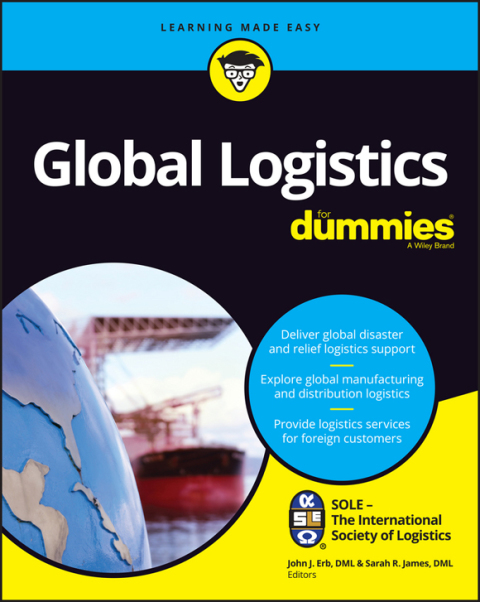Description
Efnisyfirlit
- Cover
- Introduction
- About This Book
- Foolish Assumptions
- Icons Used in This Book
- Beyond the Book
- Where to Go from Here
- Part 1: Taking Your First Global Steps
- Chapter 1: Getting Started in Global Logistics
- Understanding the Evolution of Global Logistics
- Introducing SOLE – The International Society of Logistics
- Getting Started: Some Basic Logistics Concepts
- Deconflicting Some Unique Language of Global Logistics
- Identifying the Need for This Global Logistics Discussion
- Chapter 2: Understanding the Role of Logistics in Global Manufacturing and Sales
- Manufacturing in a Foreign Location
- Dealing with Foreign Distribution Chains
- Anticipating the Impact of Geo-Politics and Social Change
- Adapting to the Logistics of Global Internet Sales
- Chapter 3: Providing Global Logistics Services
- Defining Logistics Services and Logistics Service Providers
- Providing Global Logistics Services
- Culture, Culture, Culture
- Working for Government Clients
- Chapter 4: Supporting Global Humanitarian and Disaster Relief Efforts
- Directing and Managing International Disaster Relief Efforts
- Organizing for H&DR Logistics Support
- Providing Logistics Support to H&DR Events: Dangerous but Rewarding
- Part 2: Manufacturing in a Global Environment
- Chapter 5: Making Your Product and Establishing Your Global Supply Chain
- Establishing Your Presence
- Deciding How to Support
- Managing Your Global Logistics Operation
- Chapter 6: Stocking and Distributing Your Products
- Building and Managing Your Inventory
- Warehousing and Distributing
- Shipping and Receiving: From Beginning to End
- Chapter 7: “Greening ” Your Manufacturing Line
- Safeguarding the Environment
- Growing a Green Operation
- Applying Green Logistics Best Practices
- Chapter 8: Keeping Everything Running Smoothly
- Maintaining the Line
- Implementing Tools and Metrics
- Managing Risks and Crisis
- Establishing a Production Continuity of Operations Plan (Production COOP)
- Chapter 9: Protecting Your Designs and Data
- Developing Your Supply Chain Risk Management Plan
- Safeguarding Your Intellectual Property
- Fighting Industrial Espionage
- Preventing and Recovering from Logistics Data Disasters
- Part 3: Selling What You’ve Already Made
- Chapter 10: Moving It from “Here” to “There”
- Choosing Your Transportation Modes
- Establishing, Managing, and Maintaining Your Own Fleet
- Using Freight Forwarders
- Chapter 11: Keeping Everything Secure
- Identifying Potential Distribution Chain Threats
- Combating Piracy: On and Off the Seas
- Screening Cargo: Both Coming and Going
- Dealing with Dunnage, Demurrage, and Damage
- Chapter 12: Making the Sale
- Identifying and Establishing Your Points of Sale
- Building a Winning Strategy
- “Capturing” the Sale
- Supporting and Educating Your Customers
- Chapter 13: Dealing with Losses, Theft, Damages, and Returns
- Minimizing the Risk at the Point of Sale
- Recovering from the Damage or Loss
- Accepting Damages and Returns: Taking It All Back
- Part 4: Providing Logistics Services to Global Customers
- Chapter 14: Understanding and Accommodating Cultural Differences
- Confronting Cultural and Language Barriers
- Understanding the Corporate Climate
- Adjusting and Responding to Social and Political Uncertainty
- Chapter 15: Identifying Insurance and License Requirements
- Identifying the Ground Rules
- Indemnifying and Protecting Your Operations
- Getting and Keeping Your Permits and Licenses
- Chapter 16: Deciding on Your Source of Manpower
- Identifying Your Labor Pool: Internal versus External
- Understanding the Difference between Expatriates, Local Nationals, and Third-Country Nationals
- Managing and Retaining Your Foreign Employees
- Chapter 17: Understanding Foreign Labor Laws and Requirements
- Integrating Labor Laws into Work Schedules
- Accommodating Religious Requirements
- Understanding the Special Provisions for Employing Women and Children
- Compensating Your Workforce
- Part 5: Being Part of a Global Humanitarian & Disaster Relief Logistics Team
- Chapter 18: Understanding Global Humanitarian and Disaster Relief Logistics
- Defining the Scope of Humanitarian and Disaster Relief
- Introducing the H&DR Logistics Delivery Framework
- Knowing and Understanding the H&DR Logistics Team
- Identifying the Phases of Operational Response
- Chapter 19: Defining Your H&DR Logistics Role
- Making the Corporate Commitment
- Deciding What H&DR Logistics Support to Provide
- Preparing Your Team: Establishing Internal Systems and Protocols
- Responding to the Call for Logistics Support
- Chapter 20: Operating as Part of the H&DR Logistics Team
- Deploying Your Humanitarian & Disaster Relief (H&DR) Logistics Team
- Conducting H&DR Logistics Operations
- Closing out the Team’s Mission: Reporting Out and Returning Home
- Part 6: The Part of Tens
- Chapter 21: Ten “Stars” of Global Logistics
- Amazon.com: Leveraging E-Commerce to Support a Global Logistics Enterprise
- Coca-Cola: Investing in Product Sustainment in Foreign Communities
- Dell: Moving Manufacturing to Capture Global Demand
- International Federation of Red Cross & Red Crescent Societies: Disaster Relief
- International Flavors & Fragrances: Integrating Multiple Supply Chains
- Mali: Revolutionizing the Logistics of Exporting Agricultural Products
- McDonald’s and Starbucks: Adapting to Local Customs, Traditions, and Tastes
- Toyota: Streamlining the Global Management of Inventory
- Volvo: Designing the Environment into Product Engineering
- Walmart: Pioneering the Commercial Use of RFID
- Chapter 22: Ten Examples of Global Logistics Gone Wrong
- Best Buy Europe: Underestimating Cultural Differences in Technology Purchasing
- Boise Cascade: Undone by Local Politics
- British Petroleum: Inadequate Global Operating Standards
- Ford Motor Company: Operational Mismatches
- Home Depot: Missing the Cultural Mark
- Korean Airlines: Older Is Not Always Wiser
- Nestlé: Failing to Understand the Actual Market
- SNC Lavalin: Crossing the Ethical Line
- Target: Global Is Better Only if Your Logistics Infrastructure Can Support It
- Uber: Using Technology to Circumvent Regulatory Requirements
- Chapter 23: Top Ten Resources
- Global Logistics Manufacturing and Distribution
- Global Logistics Services
- Global Humanitarian and Disaster Relief Logistics
- Glossary
- About the Authors
- Advertisement Page
- Connect with Dummies
- End User License Agreement






Reviews
There are no reviews yet.